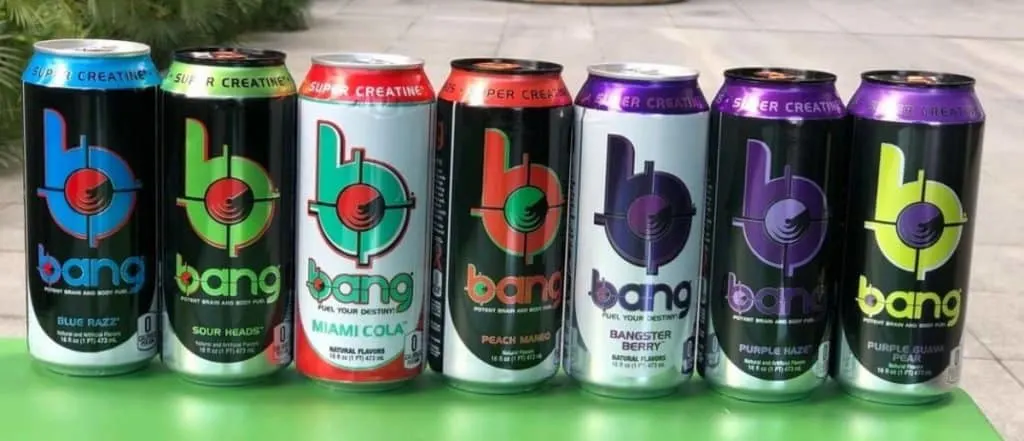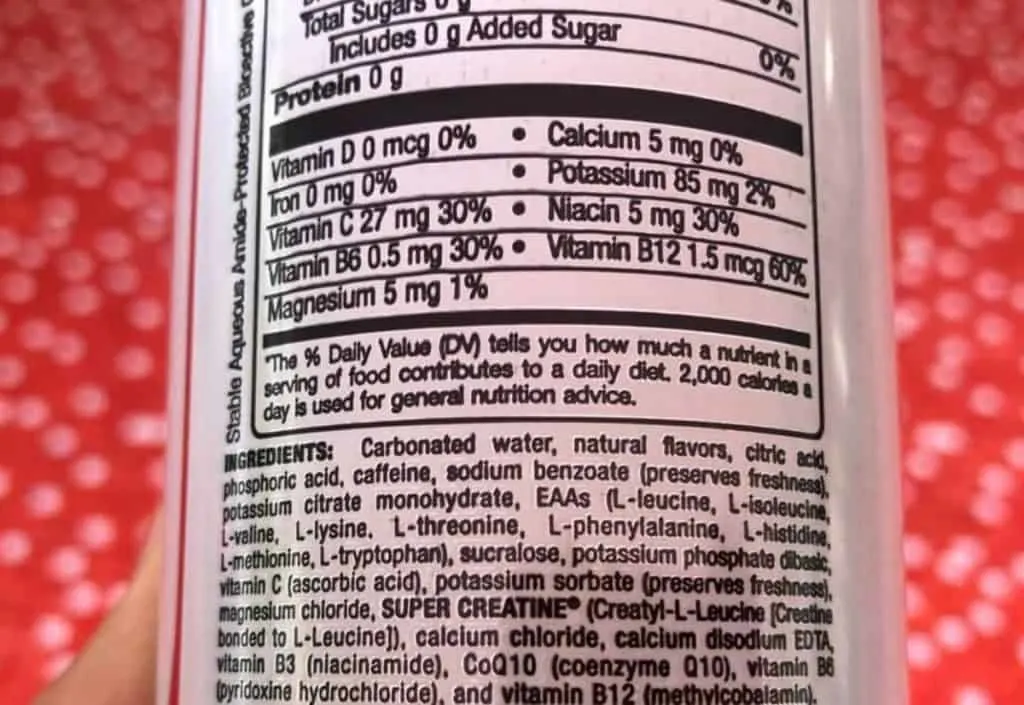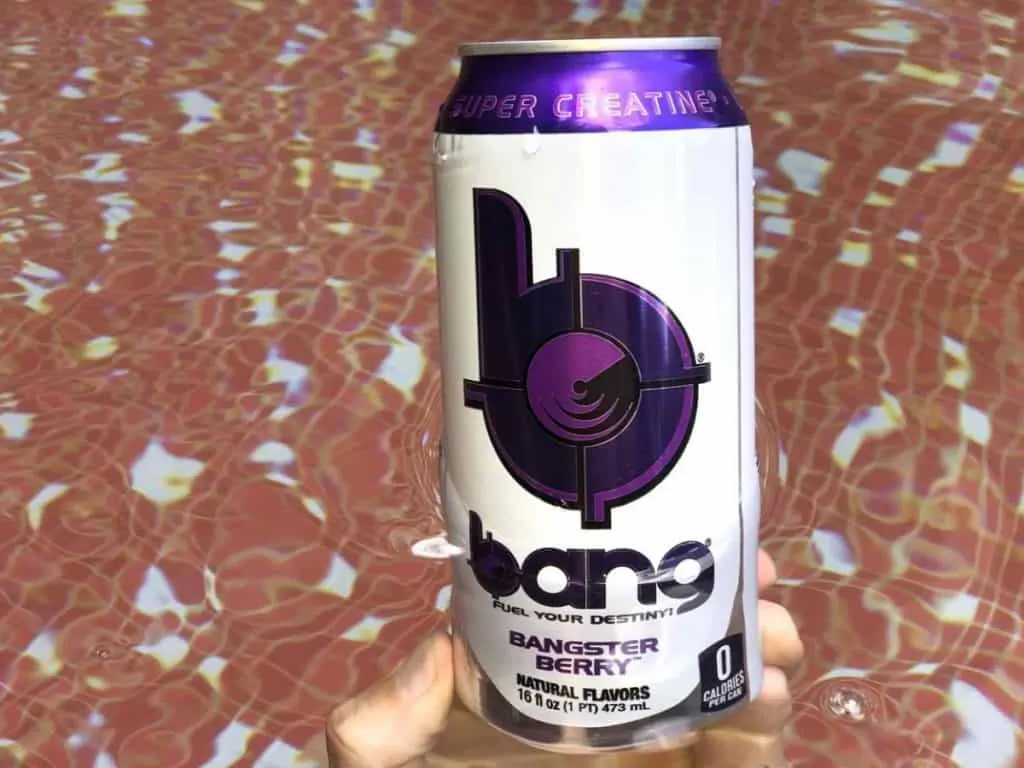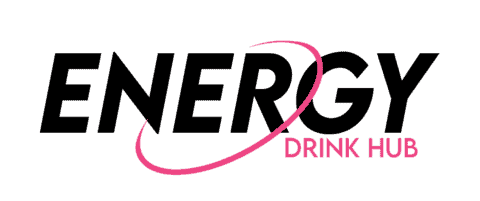For a brief: A can of 16 fl. oz Bang contains 300 mg caffeine, BCAAs, Coenzyme, Super Creatine, amino and other ingredients designed to give you a strong energy boost. And some headache, if taken irresponsibly!
Bang is an American brand energy drink made by Vital Pharmaceuticals, Inc. and is well known for its crazy 300 mg caffeine kick.
It is gaining popularity in recent years making it the third most preferred energy drink behind the dominating giants, Monster and Red Bull.
Bang is for anyone who is physically active or involved in anything extreme that requires physical strength. Surely, the 300 mg caffeine is more than enough to keep you going!
Let’s dig deeper to what’s in a can of Bang to find out if it is worth considering.
If you’re ready, let’s keep the ball rolling.

Page Contents
Bang Ingredients
- Carbonated Water
- Citric Acid
- Phosphoric Acid
- Caffeine
- Sodium Benzoate
- Potassium Sorbate (preservative)
- Potassium Citrate Monohydrate
- EAAs
- Sucralose
- Natural and Artificial Flavors
- Potassium Phosphate Dibasic
- Vitamin C
- Potassium Sorbate
- Acesulfame Potassium
- Magnesium Chloride
- Super Creatine
- Calcium Chloride
- Calcium Chloride
- Calcium Disodium EDTA
- CoQ10
- B-Vitamins

Band Energy Drink Nutrition Facts
For reference, let’s have a quick look at the nutritional value of Bang Energy as shown in the table below:
| Content | Amount |
| Fat | 0 g |
| Cholesterol | 0 g |
| Sodium | 40 g |
| Carbohydrate | 0 g |
| Vitamin D | 0 mcg |
| Iron | 0 mg |
| Vitamin C | 27 mg |
| Vitamin B6 | 0.5 mg |
| Magnesium | 5 mg |
| Calcium | 5 mg |
| Potassium | 85 mg |
| Niacin | 5 mg |
| Vitamin B12 | 1.5 mcg |
| Caffeine | 300 mg |

What is Healthier Coffee or Bang?
Coffee is healthier than Bang Energy Drink. Even though Bang Energy Drink might provide you a rush of energy, coffee has more natural components, including antioxidants and natural nutrients, which makes it the better and the more healthy choice overall.
Does Bang More Caffeine than Average Coffee Cup?
Bang has more caffeine than the average coffee cup. It has approximately double the amount that is found in one cup of coffee (170 mg in a 15-ounce serving) and is equivalent to 75% of the daily caffeine intake that is recommended by the FDA.
Bang Caffeine Content
A can of 16 fl. oz Bang contains an astonishing 300 mg of caffeine.
To put it in perspective, 300mg is equivalent to 2 to 3 cups of coffee which is pretty close to the recommended intake per day which is 400 mg.
But don’t be too alarmed. You’ll be fine as long as you don’t overconsume.
Besides, caffeine is beneficial to your health, if taken in moderation. Some of the possible health benefits of caffeine include:
- delay tiredness
- reduces depression
- boost metabolism
- promote weight loss
- enhanced exercise performance
As for balance, let’s have a look at the hazards of caffeine which includes:
- addiction
- high blood pressure
- digestive issues
- insomnia
- anxiety
- muscle breakdown
- rapid heart rate
Caffeine OD is no joke! It can be fatal if left untreated.
After caffeine wears off, this may leave you with an unpleasant energy crash and be tempted to get more caffeine to feel better which can result in addiction.
That being said, I strongly recommend limiting your intake of any caffeinated beverages, including Bang.
And perhaps, go for something more natural if you need an energy boost.
Is 300 mg caffeine a lot?
Quick answer: It depends on your level of caffeine tolerance.
If we look at the suggested intake per day, 300 mg caffeine is not a massive amount, if you are a healthy individual with no caffeine issues.
Bang originally contained 357 mg of caffeine per can but it was cut back to 300 mg which is still within the limit.
The safe amount of caffeine is different for every individual depending on a number of factors such as the tolerance or sensitivity to caffeine, metabolism, weight, age, and sex.
To be safe, my advice is to only consume one can of Bang per day. And if you’re new to caffeinated drinks, do not drink them in one go to avoid system shock.
Watch out for the early symptoms of caffeine OD such as:
- headache
- nausea
- diarrhea
- vomiting
- palpitations
What are the bad ingredients in Bang?
Sucralose, acesulfame potassium, and sodium benzoate are Bang ingredients that can possibly harm your health, if consumed inappropriately.
Sucralose is zero-calorie sweetener found in Bang Energy. It is used to sweeten food without adding carbohydrates or calories to it.
It is 600 times sweeter than sugar and is usually mixed with other artificial sweetener to disguise the bitter aftertaste.
As far as FDA is concerned, sucralose is safe to consume for general use.
However, there are conflicting research about it such as increased blood and glucose level and decreased insulin sensitivity. It could negatively affect people who are using it to manage their sugar consumption and blood glucose levels.
Sodium benzoate, on the other hand, is best known as a food preservative and is also used to extend shelf life of food and beverages.
It inhibits the growth of bacteria, mold, and microbes, which can potentially lead to spoilage.
However, it is a versatile chemical preservative with medicinal effects and is also approved for general use by health authorities such as FDA.
Acesulfame potassium is another ingredient found in Bang. Sometimes it is also referred to as E950 or Ace K.
It is a no-calorie sweetener that is 200 times sweeter than sugar. Ace K is usually blended with sucralose and aspartame to mask the bitter taste of food and beverages.
There are research that suggests the dangers of acesulfame potassium to overall health. For example, it is linked to cancer but National Cancer Institute (NCI) believed there is no connection.
But, so far so good, if you drink Bang in moderation, I don’t really believe sucralose and sodium benzoate can put you at risk of major health issues.
Other Bang Energy Ingredients (Brief Description)
SUPER CREATINE

It is hard to tell how much SUPER CREATINE is in a can of Bang Energy.
I’ve seen a few articles claiming 4 to 32.5 mg of creatine and amino acids found in Bang Energy but that still need to be proven.
Super Creatine, is by far, the most notable ingredient in Bang. Bang has had success in the synthetic creation of combining creatine to the amino-acid, L-leucine.
The result: Super Creatinine otherwise known as Creatine-L-Leucine the only kind in the world.
Creatine naturally exists in muscle cells where it provides the fuel (energy) to do physical exercise.
And for this reason, creatine is used in can be used as an ingredients in Bang Energy and other energy supplements and beverages.
To be a step ahead, Bang produced Super Creatine. They reasoned that their compound would even cross the blood-brain barrier to fuel the brain as it is now a water stable and water-soluble form of its kind.
As for the benefits of Super Creatine, I can’t really find a specific article or study that relates to it.
The articles that I came across are focused on the benefits of creatine and combining creatine and super creatine together.
It looks like creatine and super creatine combined together compensates for the loss of creatine in the body which benefit you from gaining more workout energy.
Moreover, super creatine is said to be beneficial in terms of improving mental concentration because the brain absorbs it easily than regular creatine.
Keep in mind that this statement is not validated by FDA. So, tread lightly!
BCAAs
It is hard to tell how much BCAAs are in Bang as we can only see L-leucine and L-Valine on the ingredients and it only appear in “trace amounts.”
L-leucine and L-Valine are amongst the BCAAs (Branched Chained Amino Acids present in Bang. It works by providing an additional fuel to the working muscle which increases your energy when working out.
The recommended intake of BCAAs is 4 to 20 g per day (at least 3 capsules of BCAAs) but such a dosage is still debatable.
Although, we can’t tell how much exactly are the BCAA in Bang Energy, I would like to assume that we can at least get a few amount to gain some of its benefits.
Some of the known benefits of BCAA includes:
- delay fatigue during prolonged exercise
- improves aerobic and anaerobic exercise
- fortify the immune system
- protect lean muscle
- promote muscle protein synthesis
- reduced muscle soreness and damage
B-Vitamins
B-Vitamins play a key role in making sure that the body’s cell are functioning well. It is responsible for helping the body convert food into energy, maintain healthy skin, brain, and other body tissues, as well as create new blood cells.
The B-Vitamins found in Bang Energy includes:
The health benefits of B-Vitamins includes:
- reduce fatigue and boost mood
- reduce anxiety and depression symptoms
- improved cognitive performance
CoQ10
CoQ10 or Coenzyme Q10 is a vitamin-like substance naturally found throughout the body. It plays a key role in metabolism and is used to protect cells from damage.
The truth is, there is only small amount of CoQ10 found in a can of Bang Energy. In my opinion, you can’t really get the full effects of CoQ10 in a can of Bang.
However, these are some of the possible health benefits on CoQ10:
- lower blood pressure
- treat heart failure
- treat migraine headaches
- slows Alzheimer’s progression
The recommended daily dose for CoQ10 is 100-200 mg and although this enzyme is mixed in energy drinks, there is a lack of evidence that it can boost energy.
Beta-Alanine
Beta-Alanine is a non essential amino acid used as an ingredient in Caffeine-Free Bang. It is also a popular supplement used by athletes and fitness enthusiast as an energy booster.
This research study shows that Beta-Alanine increases muscle carnosine concentrations, enhances exercise performance as well as reduces neuromuscular fatigue if taken in daily of 4 to 6 g for at least 2 to 4 weeks.
Some of the benefits of beta-alanine includes:
- reduced fatigue
- increased endurance
- improved heart health
On the other hand, one of the most known side effects of beta-alanine is paraesthesia or “tingling” which is usually experienced in the neck, face, and back of the hands.
Paraesthesia can be relieved by decreasing dosage around 800 mg at a time.
Another side effect if you overconsume beta-alanine is the decline in taurine level – this happen because beta-alanine is competing against taurine for muscle absorption.
Rest assured, the amount of beta-alanine present in Caffeine-Free Bang is safe to consume overall.
How much caffeine is too much?
Caffeine can be a part of a balanced diet when consumed in moderation. Individual reactions vary, but generally, people may start experiencing side effects when consuming caffeine above 400mg.
It’s important to be mindful of your own tolerance and listen to your body when consuming caffeine to determine what works best for you.
Who should avoid caffeine?
While caffeine is generally safe in moderation, certain individuals should limit or avoid it. Pregnant women, and individuals with certain medical conditions like heart problems or high blood pressure are advised to avoid caffeine.
Consultation with a healthcare professional is also recommended.
What’s is Caffeine-Free Bang?
Caffeine-Free Bang contains similar ingredients to the regular Bang, except the Beta-Alanine used as a caffeine substitute.
Blimey! This came as a surprise as Bang is well known for drinks with strong caffeine formulation.
Caffeine-Free Bang is marketed to people with caffeine sensitivity issues and anyone who want to enjoy a caffeine-free drink any time of the day.
However, there are side effects associated with caffeine substitute such as Beta-Alanine. Paresthesia (tingling) is one of them which can be reduced by lowering dosage intake.
But that shouldn’t be a problem, as long as you consume it in moderation.
Give this video a watch to get an idea of how Caffeine-Free Bang taste like!
Bang Energy Drink Alternatives
Here are my top recommendations if you’re looking for an alternative energy drink to Bang.
- Red Bull
- Monster
- Bang
- Rockstar
- 3D Energy
In summary
If you want an extreme push with optimized focus, this bad boy Bang won’t let you down during intense workout sessions or any physical activities.
A can of 16 fl. oz Bang contains 300 mg caffeine, BCAAs, amino acids, B-Vitamins, and other ingredients to give you high energy boost.
All in all, I can say that the caffeine and ingredients in bad is not bad at all, as long as you limit your intake to one can per day.
Some of the ingredients in Bang are a little controversial and I understand why it might put you off from choosing such as energy booster.
But those ingredients were approved by FDA for general use. So, nothing to worry about it, as long as, you intend to drink it the way it should be.
I reckon it might be the right energy drink for you if you’re someone who loves prolong workout sessions and extreme sports. The ingredients in Bang combined with caffeine are meant for this purpose.
Perhaps Bang’s slogan “potent brain and body fuel” can drive this suggestion further home.
Don’t buy Bang without first checking out my Bang buying guide to ensure you don’t pay too much and get the best deal possible.
